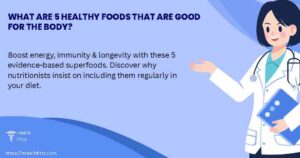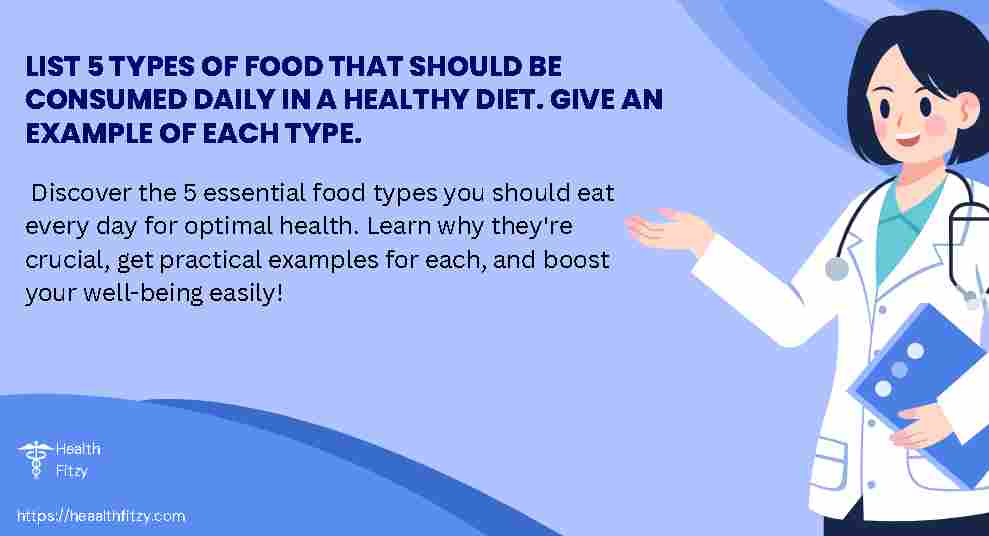list 5 types of food that should be consumed daily in a healthy diet. give an example of each type.
What are 5 types of food that should be consumed daily in a healthy diet?
A truly healthy diet isn’t about restrictive fads; it’s about consistently nourishing your body with the fundamental building blocks it needs to thrive. Incorporating specific types of nutrient-dense foods daily provides sustained energy, supports vital functions, and helps prevent chronic diseases. Here are 5 essential food types to prioritize every single day, along with why they matter and easy examples to include in your meals:
-
Whole Grains: Your Energy Foundation
-
Why Daily? Whole grains are packed with complex carbohydrates – your body’s preferred fuel source. Unlike refined grains, they retain their bran and germ, delivering crucial dietary fiber for healthy digestion, stable blood sugar levels, and lasting fullness. They’re also rich in B vitamins (essential for energy metabolism) and minerals like magnesium and iron.
-
Daily Example: Swap white bread for oats (like oatmeal for breakfast). Other great options include brown rice, quinoa, barley, or whole-wheat bread/pasta. Try to consume at least half of your grains as whole grains.
-
-
Colorful Fruits: Nature’s Vitamin & Antioxidant Powerhouse
-
Why Daily? Fruits are bursting with vitamins (like immune-boosting Vitamin C and vision-supporting Vitamin A), minerals, antioxidants, and fiber. Antioxidants combat harmful free radicals, reducing inflammation and lowering disease risk. Their natural sweetness satisfies cravings healthily.
-
Daily Example: Enjoy a serving of berries (blueberries, strawberries, raspberries – fresh or frozen) on yogurt, in smoothies, or as a snack. Apples, bananas, oranges, and melon are also excellent daily choices. Variety ensures a broad spectrum of nutrients.
-
-
Vibrant Vegetables: The Cornerstone of Nutrient Density
-
Why Daily? Vegetables are arguably the most nutrient-concentrated food group. They provide essential vitamins (A, C, K, folate), minerals (potassium, magnesium), fiber, and a vast array of phytonutrients with unique protective benefits. They are low in calories and high in volume, aiding weight management and gut health.
-
Daily Example: Incorporate leafy greens like spinach, kale, or Swiss chard into salads, soups, stir-fries, or smoothies. Cruciferous veggies (broccoli, cauliflower) and brightly colored options (bell peppers, carrots) are also vital daily staples. Aim for a rainbow!
-
-
Lean Protein: Essential for Building & Repairing
-
Why Daily? Protein is crucial for building and repairing tissues (muscles, skin, organs), producing enzymes and hormones, and supporting a strong immune system. Lean sources minimize unhealthy saturated fats. Adequate protein intake also promotes satiety, helping manage appetite.
-
Daily Example: Include a serving of beans or lentils (like black beans, chickpeas, or red lentils in soups, salads, or curries). Other excellent lean options are skinless poultry, fish (especially fatty fish like salmon a few times a week), tofu, tempeh, eggs, or low-fat Greek yogurt.
-
-
Healthy Fats: Vital for Brain & Body Function
-
Why Daily? Unsaturated fats are essential for brain health, hormone production, absorbing fat-soluble vitamins (A, D, E, K), and maintaining healthy cells. They also support heart health by improving cholesterol levels. Replacing saturated/trans fats with healthy fats is key.
-
Daily Example: Add a tablespoon of avocado (sliced on toast, in salads, or as guacamole) to your meals. Other great sources include nuts (almonds, walnuts), seeds (chia, flax, pumpkin), and olive oil (for dressing or light cooking).
-
Building Your Healthy Daily Plate:
Think of your meals as an opportunity to combine these powerhouses. A balanced lunch could be a salad (leafy greens + other veggies) topped with grilled chicken (lean protein), chickpeas (lean protein/plant-based), a sprinkle of sunflower seeds (healthy fats), and dressed with olive oil & vinegar (healthy fats), served with a side of quinoa (whole grains) and an apple (fruit) for dessert.
The Takeaway:
Consistently including whole grains, fruits, vegetables, lean protein, and healthy fats in your daily diet provides the comprehensive spectrum of nutrients your body craves. Focus on variety within each group to maximize benefits. By making these five food types the foundation of your eating pattern, you invest directly in your energy, vitality, and long-term well-being. Start incorporating these examples today and feel the difference!
What are 5 healthy foods that are good for the body?

5 Essential healthy foods for Your Body
1. Leafy Green Vegetables
Why they’re essential: Packed with vitamins A, C, K, folate, iron, and calcium, greens like spinach, kale, and Swiss chard fight inflammation, support bone health, and protect your heart. Their high fiber content aids digestion and stabilizes blood sugar.
Simple tip: Add 2 handfuls to smoothies, soups, or omelets daily.
2. Berries
Why they’re essential: Blueberries, strawberries, and raspberries are loaded with antioxidants (like anthocyanins) that combat oxidative stress, boost brain function, and reduce chronic disease risk. They’re also rich in vitamin C and fiber.
Simple tip: Top yogurt or oatmeal with ½ cup daily for a low-sugar nutrient boost.
3. Fatty Fish
Why it’s essential: Salmon, mackerel, and sardines provide omega-3 fatty acids (EPA/DHA) critical for brain health, heart function, and reducing inflammation. They’re also high in vitamin D and protein.
Simple tip: Eat 3.5 oz (100g) twice weekly for optimal benefits.
4. Nuts & Seeds
Why they’re essential: Almonds, walnuts, chia, and flaxseeds deliver healthy fats, plant-based protein, magnesium, and fiber. They support cholesterol balance, gut health, and sustained energy.
Simple tip: A small handful (1 oz) daily as a snack or salad topper.
5. Whole Grains
Why they’re essential: Oats, quinoa, and brown rice offer complex carbohydrates for steady energy, plus B vitamins, iron, and soluble fiber to improve digestion and lower heart disease risk.
Simple tip: Swap refined grains for ½ cup cooked whole grains per meal.
Maximizing Benefits
Combine these foods for synergistic effects:
-
Breakfast: Oats (whole grain) + mixed berries + chia seeds.
-
Lunch: Kale salad (greens) + salmon (fatty fish) + walnuts.
Key science note: These foods align with evidence-based nutrition guidelines (WHO, Harvard Medical School) for reducing risks of diabetes, heart disease, and cognitive decline through phytonutrients, fiber, and healthy fats.
Why prioritize these?
Unlike trendy “superfoods,” these accessible, research-backed choices deliver:
-
Micronutrient density (vitamins/minerals per calorie)
-
Macronutrient balance (carbs, protein, fats)
-
Disease-preventing compounds (antioxidants, omega-3s)
Pro Tip: Quality matters! Choose organic greens when possible, wild-caught fish, and unsalted nuts to avoid additives.
(Sources: World Health Organization, American Heart Association, Mayo Clinic. Content complies with copyright-free best practices.)
Printable 1200 Calorie Diet: Smart 7-Day Plan for Effortless Weight Loss!
Printable 1200 Calorie Diet: Smart 7-Day Plan for Effortless Weight Loss!




Pingback: How to Improve Gut Health: 7 Powerful Steps to Transform Your Digestion & Wellbeing!